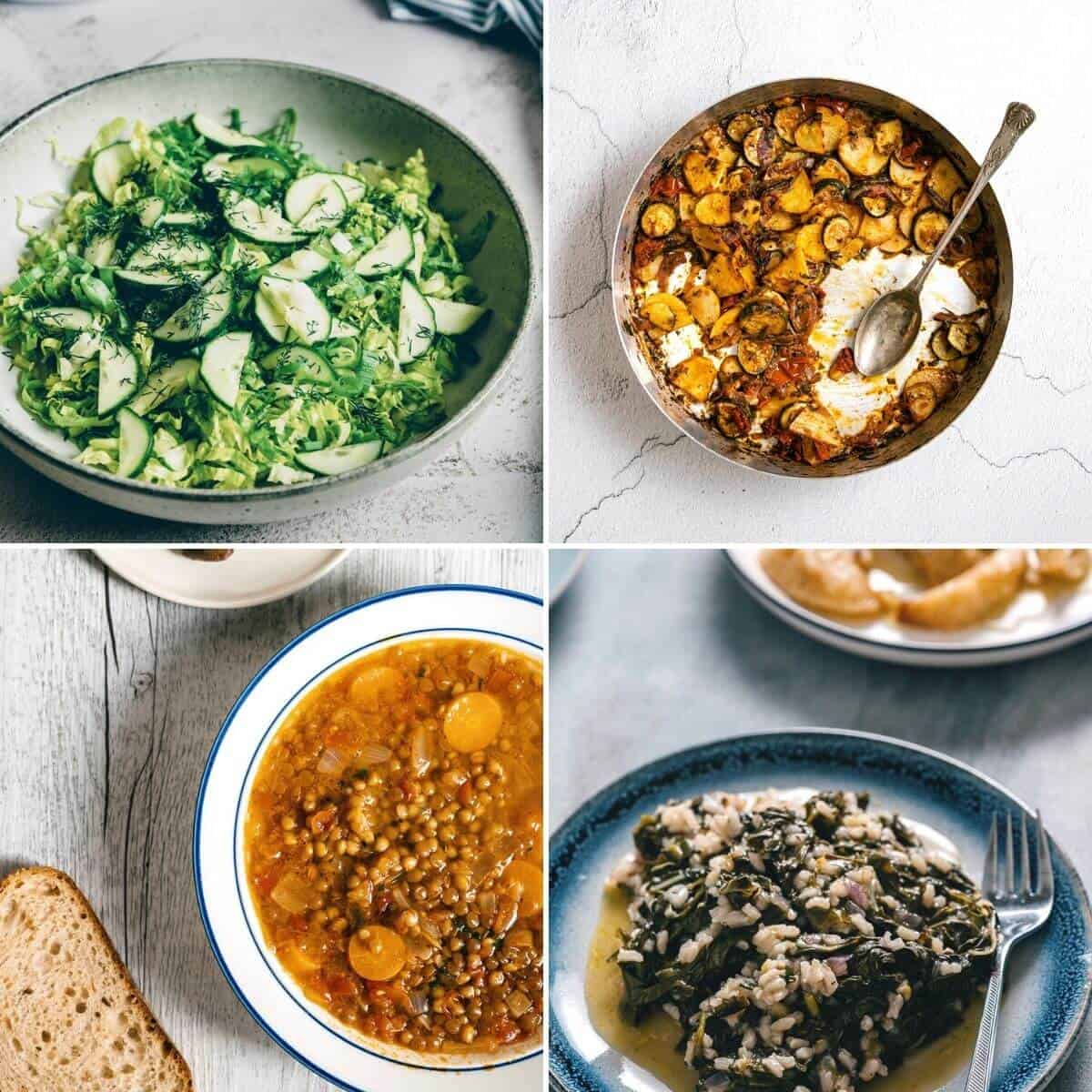Imagine a sun-drenched Greek island, the scent of oregano and thyme mingling with the salty sea air. Now, picture translating that vibrant culinary experience into refreshing, raw vegan dishes perfect for a summer feast. This exploration delves into the art of creating delicious and healthy Greek-inspired meals without compromising on flavor or texture. We’ll uncover the secrets to transforming classic Greek recipes into vibrant, plant-based masterpieces, showcasing the surprising versatility of raw ingredients and highlighting the stunning visual appeal of each dish.
From the crisp crunch of a revitalized Greek salad to the delicate layers of a raw spanakopita, we’ll guide you through detailed, step-by-step recipes, complete with captivating images. We’ll uncover the key flavor profiles of traditional Greek cuisine and how to replicate them using only raw ingredients, exploring substitutions for common ingredients and introducing unique raw vegan elements that add an authentic Greek twist. Discover creative presentation techniques and serving suggestions to elevate your culinary creations, transforming a simple meal into a memorable dining experience.
Popular Greek-Inspired Raw Vegan Summer Dishes
Summer brings to mind sun-drenched shores, vibrant colours, and the tantalizing flavours of Greece. This section explores how the vibrant spirit of Greek cuisine can be reimagined through a raw vegan lens, creating dishes that are both refreshing and nourishing. These adaptations retain the essence of traditional Greek flavours while embracing a plant-based, uncooked approach.
Raw Vegan Adaptations of Popular Greek Dishes
The following table details five popular Greek dishes and their raw vegan counterparts, highlighting the substitutions made to maintain flavour and nutritional value while adhering to a raw vegan diet. The transition involves mindful swaps of ingredients, ensuring the dishes remain both delicious and healthy.
| Traditional Greek Dish | Raw Vegan Adaptation | Traditional Ingredients | Raw Vegan Substitutes |
|---|---|---|---|
| Tzatziki | Raw Vegan Tzatziki | Greek yogurt, cucumber, garlic, dill, olive oil, lemon juice, salt | Cashew cream (soaked cashews blended with water), cucumber, garlic, dill, olive oil, lemon juice, salt |
| Dolmades (Stuffed Grape Leaves) | Raw Vegan Dolmades | Grape leaves, rice, herbs (mint, dill, parsley), onions, olive oil, lemon juice | Grape leaves, quinoa or finely chopped zucchini and carrot mix, herbs (mint, dill, parsley), finely chopped red onion, olive oil, lemon juice |
| Greek Salad (Horiatiki) | Raw Vegan Greek Salad | Tomatoes, cucumbers, onions, olives, feta cheese, olive oil, oregano | Tomatoes, cucumbers, red onion, Kalamata olives, marinated artichoke hearts (for a feta-like salty tang), olive oil, oregano |
| Spanakopita (Spinach Pie) | Raw Vegan Spanakopita | Phyllo pastry, spinach, feta cheese, onions, dill, olive oil | Dehydrated zucchini or squash sheets (for a phyllo-like texture), spinach, marinated artichoke hearts, red onion, dill, olive oil |
| Avgolemono Soup | Raw Vegan Avgolemono-Inspired Soup | Chicken broth, rice, eggs, lemon juice | Vegetable broth (made from raw vegetables), quinoa or finely chopped zucchini, lemon juice, tahini (for creaminess) |
Nutritional Comparison of Traditional and Raw Vegan Versions
This table offers a general comparison of the nutritional profiles. Note that precise values vary depending on specific ingredients and preparation methods. The raw vegan versions generally boast higher levels of certain vitamins and antioxidants, while the traditional dishes might offer higher protein content from animal products.
| Nutrient | Traditional Tzatziki | Raw Vegan Tzatziki | Traditional Greek Salad | Raw Vegan Greek Salad |
|---|---|---|---|---|
| Protein (g/serving) | 8-10 | 3-5 | 5-7 | 4-6 |
| Fat (g/serving) | 15-20 | 12-18 | 10-15 | 10-15 |
| Fiber (g/serving) | 2-3 | 6-8 | 4-6 | 6-8 |
| Vitamin C (mg/serving) | 10-15 | 20-30 | 25-40 | 30-45 |
Recipe Variations and Customization

The beauty of raw vegan Greek cuisine lies in its adaptability. Simple swaps and substitutions allow for endless variations, catering to diverse palates and dietary needs. This section explores creative modifications to a classic raw vegan Greek pasta salad, offering options to boost protein, highlight vibrant vegetables, and intensify herbal flavors. We will also address common dietary restrictions and provide guidance on scaling recipes for different group sizes.
Raw Vegan Greek Pasta Salad Variations
Three distinct variations of a raw vegan Greek pasta salad are presented below, each emphasizing a different aspect of the dish. These examples demonstrate how easily you can adjust the recipe to suit individual preferences and create unique culinary experiences.
Variation 1: Protein-Packed Powerhouse
This version focuses on maximizing protein content. Imagine a vibrant salad brimming with the creamy texture of raw cashews, providing a rich, satisfying protein base. Instead of traditional zucchini noodles, we utilize hearts of palm pasta, adding a delightful firmness and subtle sweetness. Sun-dried tomatoes burst with intense flavor, complementing the earthy notes of Kalamata olives. A sprinkle of toasted pumpkin seeds adds a satisfying crunch and extra dose of protein. The dressing remains a classic lemon-tahini concoction, binding all the elements together in a harmonious dance of textures and tastes.
Variation 2: Vegetable Fiesta
This variation showcases a rainbow of fresh summer vegetables. Picture vivid red bell peppers, their sweetness contrasting beautifully with the peppery bite of arugula. The pasta of choice is thinly sliced cucumber, adding a refreshing crunch and hydrating element. Cherry tomatoes, halved for maximum juiciness, contribute bursts of sweetness and vibrant color. A generous helping of finely chopped red onion adds a sharp tang. The dressing is a simple yet elegant blend of olive oil, lemon juice, and fresh dill, allowing the natural flavors of the vegetables to shine.
Variation 3: Herb-Infused Delight
This version prioritizes the aromatic complexity of fresh herbs. Imagine a symphony of flavors where the subtle sweetness of zucchini noodles intertwines with the robust aroma of fresh oregano, thyme, and mint. Capers add a salty, briny counterpoint to the delicate herbs. A handful of chopped walnuts contributes both healthy fats and a pleasant textural contrast. The dressing, a vibrant green emulsion of parsley, olive oil, and lemon juice, ties everything together, creating a refreshingly herbaceous experience. The visual appeal is captivating, a vibrant green punctuated by pops of color from the herbs and other ingredients.
Accommodating Dietary Restrictions
Adapting recipes to accommodate dietary restrictions is straightforward. For those with nut allergies, sunflower seed butter can easily replace cashew cream in the protein-packed variation. Pumpkin seeds can also be substituted for walnuts in the herb-infused version, maintaining the desired textural element. Hemp seeds are another excellent source of protein that can be incorporated into any of the variations. Always check ingredient labels to ensure products are free of allergens. Substituting ingredients requires careful consideration of flavor profiles and textures, but creative experimentation often leads to delightful discoveries.
Scaling Recipes
Scaling recipes is simply a matter of adjusting ingredient quantities proportionally. For instance, doubling a recipe involves multiplying each ingredient amount by two. Conversely, halving a recipe involves dividing each amount by two. It’s important to maintain the correct ratios between ingredients to ensure the desired flavor and texture are preserved. For larger gatherings, consider preparing individual components separately and combining them just before serving to maintain freshness and prevent sogginess. This method allows for easy scaling and efficient preparation.
Embarking on this culinary journey into the world of raw vegan Greek cuisine unveils a surprising abundance of flavor and texture. By mastering the art of substitution and embracing creative presentation, you can transform familiar Greek dishes into light, refreshing, and visually stunning summer meals. The vibrant colors, fresh herbs, and satisfying textures will tantalize your taste buds and leave you feeling nourished and invigorated. So, gather your ingredients, let your creativity flow, and prepare to savor the sun-kissed flavors of Greece, reimagined for a healthy and vibrant summer.
Top FAQs
Can I make these dishes ahead of time?
Many raw vegan dishes are best enjoyed fresh, but some, like the Greek salad, can be prepared a few hours in advance. Store them properly refrigerated to maintain freshness and prevent wilting.
Are these recipes suitable for large gatherings?
Yes! The recipes can easily be scaled up to accommodate larger groups. Instructions on scaling recipes are included in the guide.
What if I have a nut allergy?
Several recipes offer alternative options for nut-based ingredients. Consult the section on dietary restrictions for specific substitutions and guidance.
Where can I find the specific ingredients?
Many ingredients can be found in health food stores, specialty markets, and online retailers. Local farmers’ markets are also a great source for fresh, seasonal produce.


